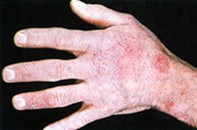Peer Reviewed
Feature Article Occupational health
Occupational skin disease: focus on contact dermatitis
Abstract
Occupational skin disease can have considerable impact on one’s working life. Early diagnosis is important, as persistence of this skin condition can be associated with a worse prognosis. GPs have a major part to play in the early recognition of this condition.
Key Points
- Occupational skin disease can be disabling. Contact dermatitis accounts for most cases of occupational skin disease. The prognosis of occupational contact dermatitis may worsen if the diagnosis is delayed, thus early diagnosis is important.
- Irritant contact dermatitis is more common than, and may coexist with, allergic contact dermatitis. Whereas irritant contact dermatitis is caused by direct skin damage, allergic contact dermatitis is caused by a delayed hypersensitivity reaction.
- People with a history of eczema should be advised to avoid occupations that entail wet work, which are associated with a higher risk of irritant contact dermatitis.
- Allergic contact dermatitis may be strongly suspected on history and examination, but can only be diagnosed with patch testing, which is traditionally performed by dermatologists. Patch testing establishes delayed hypersensitivity but not immediate hypersensitivity, which is tested for by prick testing.
- Latex allergy may complicate contact dermatitis, and this possibility should be assessed with a RAST test in those wearing rubber gloves.
Purchase the PDF version of this article
Already a subscriber? Login here.

